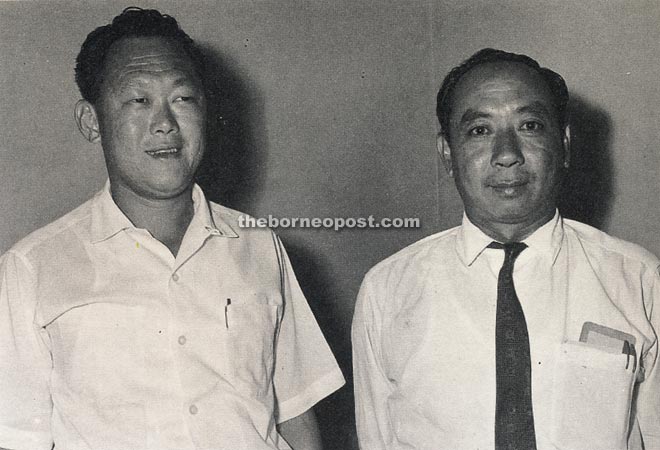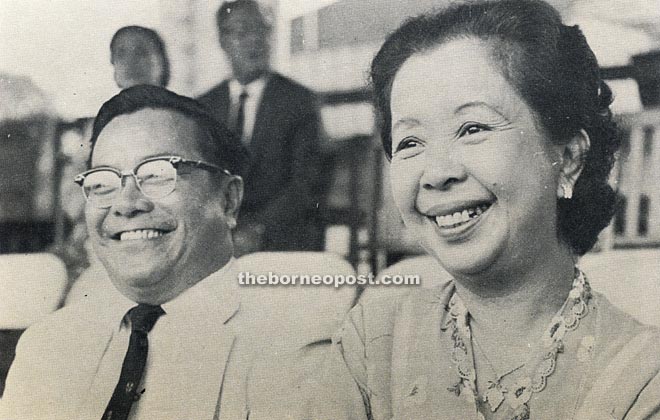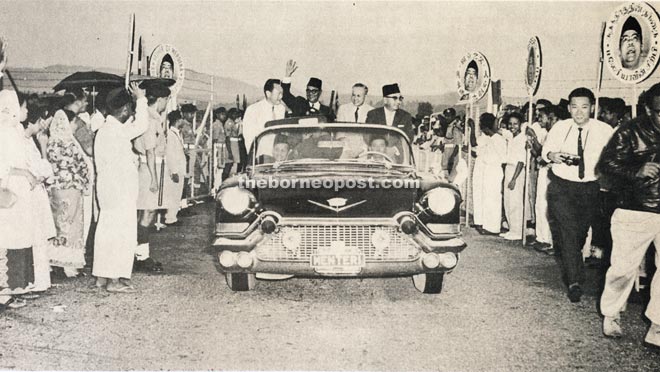
Sarawak Alliance party leaders which included (from left) Tan Sri Datuk Amar Stephen Kalong Ningkan, Temenggong Oyong Lawai Jau, Tun Datuk Patinggi Jugah Barieng, Tun Abdul Rahman Yakub and Tan Sri Ling Beng Siew speaking at Kuching airport on Aug 16, 1963 after their return from Kuala Lumpur.

Prime Minister of Singapore Lee Kuan Yew (left) and Goh Keng Swee, the Minister of Finance, Singapore.

Tan Sri Ong Kee Hui and wife.

(From left) Lee Kuan Yew, Abdul Rahman, Tun Tan Siew Win and Tun Abdul Razak returning from their London talks on Malaysia.

The welcoming party at the Kuching airport listening attentively to the speeches being made by the leaders of the Sarawak Alliance Party.
THE idea of a federation of British territories in South East Asia once the British Government had begun shrinking their commitments overseas was mooted as early as May 1, 1948 by the Commissioner General for the United Kingdom in South East Asia Malcolm Macdonald.
In the Borneo region the British tried to find a workable solution by fostering the formation of a North Borneo Federation from 1957 to 1960. This attempt however failed miserably due to the opposition of the Sultan of Brunei; the rise of Party Rakyat Brunei which wanted to establish Negara Kalimantan Utara linked to Indonesia; and the rising tide of communism in Sarawak spearheaded by the Sarawak Communist Clandestine Organization.
The idea of a greater federation was revived again when the threat of communism in Singapore reared its head under a new party called Barisan Socialist (Socialist Front).
To counter the threat of communism in Singapore yet still pursue its decolonisation plans, the British Government sought a merger between the anti-communist Federation of Malaya and the left wing, but non communist, PAP-controlled Singapore.
Then Prime Minister of Malaya Tunku Abdul Rahman Putra Al-Haj conceived the Malaya Raya plan to also bring in the Borneo territories of Sabah, Sarawak and Brunei.
– 27 May 1961
Abdul Rahman makes an offer of forming a federation comprising Singapore, North Borneo, Brunei and Sarawak into a federation in a speech to the Foreign Correspondents Association in Singapore:
“Malaya today as a nation realises that she cannot stand alone and in isolation… sooner or later Malaya should have an understanding with Britain and the peoples of Singapore, North Borneo, Brunei and Sarawak. It is premature for me to say now how this closer understanding can be brought about, but it is inevitable that we should look ahead to this objective and think of a plan whereby these territories can be brought closer together in political and economic cooperation.”
It was later announced on the 13th October that he had accepted an invitation to come to London in November 1961 for discussions to prepare the way for consultation with the Borneo territories without which no commitment could be entered into.
“Our reaction, mine and that of Tun Jugah and the rest of our representatives, was one of shock and surprise. The idea at that time was to have a Borneo federation. We were actively pursuing that, when then came the Tunku’s idea of the greater Federation. We were not prepared for that, so the immediate reaction was not very favourable. In the beginning, neither Tun Jugah nor any of the other native leaders were [sic]very keen [on Malaysia].” -Tan Sri Ong Kee Hui, Tun Jugah of Sarawak: Colonialism and the Iban Response by Vinston Sutlive.
– 23 July 1961
The Malaysia Solidarity Consultative Committee (MSCC) chaired by Donald Stephens was set up following a Commonwealth Parliamentary Association Regional Conference in Singapore. Its purpose was to explain the concept of Malaysia to the public, especially to the people of Sabah, Sarawak and Brunei.
The committee convened four times to discuss matters relating to the establishment of Malaysia. The first meeting was held in Sabah in August 1961, followed by Kuching in December 1961 and then in Kuala Lumpur in January 1962. The last meeting was held in Singapore in February 1962.
– 23 August 1961
A broad agreement had been reached in principle between the Prime Ministers of the Federation of Malaya and Singapore for a merger of the two territories. A Memorandum setting out Heads of Agreement for the proposed merger was published as a Singapore White Paper on the 15th November, 1961.
– 20—23 November 1961
A joint statement by the British and Malayan Governments was issued on the 23rd November, 1961 after a series of meetings in London between British and Malayan Ministers examining the proposal to create a ‘Federation of Malaysia’ which would embrace the Federation of Malaya, Singapore, North Borneo, Sarawak and Brunei.
It was agreed that before coming to any final decision it was necessary to ascertain the views of the peoples of North Borneo and Sarawak. A commission composed of a Chairman and four members, two nominated by the British Government and two by the Malayan Government would carry out this task and make recommendations.
“As one who is a descendant of a Chinese immigrant and who firmly believes that the future of all our people in Malaysia depends upon our being united in one nation, I would like to see a fair balance of interests maintained between the indigenous people, the Dayaks, Dusuns, Muruts, the Malays and the immigrant Chinese and Indians. Naturally I would be most unhappy to see any of the discrimination which is practised against the Chinese in almost every country in Southeast Asia except our five territories of Malaysia. And Malaysia offers us this hope of finding a just balance of interest between the descendants of the immigrant people and the indigenous people.” – Lee Kuan Yew, broadcast speech over Radio Sarawak on 19 December 1961.
– 16 January I962
The appointment of the Chairman and members of the Commission was announced by the British and Malayan Governments.
The Governments of North Borneo and Sarawak issued papers explaining the purpose of the Commission and setting out the idea of Malaysia in simple terms in order to assist people to understand the issues on which their views would be sought.
A copy of the committee’s ‘Memorandum on Malaysia’ dated 3rd February I962, was submitted for consideration by the Commission.
– 15 February 1962
Jugah in his capacity as Temenggong assembles 51 elected Pengarah and Penghulu in Kapit to discuss the proposals for a Federation of Malaysia set out in the Sarawak Government’s Paper in what became known as the Kapit Conference.
Among the resolutions discussed and presented to the Commission when they visited Kapit on the 19th March 1962 were:
1. The Head of the State of Sarawak to be a native of Sarawak.
2. The Head of each State in the Federation of Malaysia to be eligible in due course to be the Head of the Federation of Malaysia.
3. Adat Lama (traditional custom) to remain under the control of the Government of the State of Sarawak as it has until today.
4. Land to be under the control of the State.
5. English to remain the official language of the State of Sarawak and to continue to be one of the official languages of Malaysia.
6. Freedom of religious worship.
7. There is to be adequate representation for Sarawak in the Federal Government.
8. British officers to remain until replaced by properly qualified local people. Natives to have a fair share of Government employment.
9. Sarawak natives to enjoy the same status and privileges as Malays in Malaya.
10. Education to be a Federal subject and to be equalised throughout Malaysia as soon as possible. Sarawak natives to have a fair share of overseas scholarships.
11. Immigration to remain under the control of the State of Sarawak.
12. Powers reserved in the Constitution of a State may not be changed without the agreement of the State.
13. Development in Sarawak to be accelerated.
Tun Jugah of Sarawak: Colonialism and the Iban Response by Vinston Sutlive.
– 18 February 1962 – April 1962
The chairman and British members or the Commission met the Malayan members in Singapore and the whole Commission arrived in Kuching by air on the 19th February. They held their first full meeting that same afternoon, and began hearings in Kuching the following day.
All persons who wished to submit written memoranda to the Commission were invited to do so.
They received some 2,100 letters and memoranda (nearly 600 in North Borneo and over 1,600 in Sarawak) from town boards, district council, associations of many kinds, political parties, chambers of commerce, trade unions, religious leaders, members of executive and legislative councils, native chiefs and community leaders, and large numbers of individual members of the public. From these memoranda they obtained much valuable material and assistance.
They held 50 hearings at 35 different centres (10 centres in Sarawak and 15 in North Borneo).
Over 4,000 persons appeared in some 590 groups which varied in size from 1 to over 50.
– 1 August 1962
The Commission Report was published as CMND 1794. The Commission had unanimously agreed that a Federation of Malaysia was in the interests of North Borneo and Sarawak and that an early decision in principle should be reached.
The Report was considered in detail in a series of meetings in London in July 1962 by British and Malayan Ministers.
In light of the Report of the agreement reached between the Government of Malaya and the Government of Singapore, the British and Malayan Government decided in principle that, subject to the necessary legislation, the proposed Federation of Malaysia should be brought into being by the 31st August 1963.
The two Governments decided to establish an Inter-Governmental Committee (IGC), on which the British Malayan, North Borneo and Sarawak Governments would be represented. Its task was to work out the future constitutional arrangements, including safeguards for the special interests of North Borneo and Sarawak to cover such matters as religious freedom, education, representation in the Federal Parliament the position of the indigenous races, control of immigration, citizenship and the State Constitutions.
– August 1962
The Minister of State for Colonial Affairs, Lord Lansdowne, the Chairman of the Committee, and the Deputy Prime Minister of the Federation of Malaya, Tun Abdul Razak, the Deputy Chairman of the Committee, visited North Borneo and Sarawak and a Preparatory Meeting of the IGC was held in Jesselton on the 31st August, 1962.
– 12 September 1962
The Legislative Council of North Borneo adopted the motion that the British and Malayan Governments establish Malaysia by the 31st August, 1963, provided that the term of participation and the constitutional arrangements safeguarded the special interest of North Borneo.
It also authorised the following members of the council to represent North Borneo on the proposed IGC to prepare detailed constitutional arrangements to be laid before the council: the Chief Secretary, the Attorney-general, the Financial Secretary, Datu Mustapha Datu Harun, Khoo Siak Chiew and Donald Stephens.
– 26 September 1962
The Council Negri of Sarawak also welcomed the decision in principle of the British and Malayan Governments to establish Malaysia by the 31st August, 1963, on the understanding that the special interest of Sarawak would be safeguarded.
It also authorised the Chief Secretary, the Attorney-General, the Financial Secretary, Datu Bandar Abang Haji Mustapa, Temenggong Jugah Barieng, Montegrai Tugang, Ling Beng Siew, and Chia Chin Shin to represent Sarawak on the IGC.
– 8 October 1962
The first Sub-Committee meeting was held in Jesselton and the series of meetings concluded with Plenary meetings from Dec 18-20.
– 27 February 1963
After examining the Constitution of the Federation of Malaya upon which the Constitution of the Federation of Malaysia would be based, a report setting out the amendments, including transitional provisions necessary to meet the requirements of North Borneo and Sarawak was signed by the members of the IGC.
The report would be laid before the Legislative Council of North Borneo and the Council Negri of Sarawak for approval, once given the draft of the formal agreement would be drawn up and initialled by representatives of the United Kingdom, the Federation of Malaya, North Borneo and Sarawak.
– 9 July 1963
The Malaysia Agreement which spelled out the terms of the formation of the Federation of Malaysia was signed in London by the governments of the United Kingdom, the Federation of Malaya, North Borneo, Sarawak and Singapore (Brunei stepped down last minute).
The Malaysia Bill which was an annex to the agreement was also signed, giving effect that the British colonies of North Borneo, Sarawak and the State of Singapore should be federated with the existing States of the Federation of Malaya.
Ten days later the British House of Commons approved a draft of Malaysian laws allowing Sabah and Sarawak to form Malaysia.
The formation of the Federation of Malaysia was set for the 31st August 1963 which was then delayed another two weeks under Abdul Rahman’s behest to 16 September to give the United Nations more time to complete its study on the sentiments of the people in the Borneo territories over the merger.
–22 July 1963
The British gave Sarawak self-governing status by appointing Stephen Kalong Ningkan the first Chief Minister of Sarawak.
Sarawak’s self-governing status was on par with other British protectorates since Sir Alexander Waddell was still governor until 15th September 1963.
Sarawak achieved independence on 16 September 1963 with the declaration of independence pronounced by Ningkan during the Malaysia Day celebration held at central Padang , Kuching witnessed by Governor Datu Abang Haji Openg Abang Shafiee.
“And whereas by a Proclamation made under section 2 of the Malaysia Act, the 16th day of September, 1963 has been proclaimed as Malaysia Day:
Now wherefore I, Stephen Kalong Ningkan, the Chief Minister of Sarawak, do hereby proclaim that Sarawak has this day attained independence as a State of Malaysia.”
